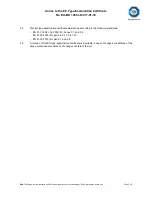
Installation and Operational Instructions for ROBA
®
-diskstop
®
Type 894.5_ _._ _ Size 10
(B.8.4.5.EN)
23/03/2017 TK/TL/GC/SU
Chr. Mayr GmbH + Co. KG
Eichenstraße 1, D-87665 Mauerstetten, Germany
Tel.: +49 8341 804-0, Fax: +49 8341 804-421
Page 4 of 16
www.mayr.com
, E-Mail:
Safety Regulations
These Safety Regulations are user hints only and may not be complete!
Dimensioning
Attention!
When dimensioning the brake, please take into consideration
whether a load torque is present when selecting the protection.
Load torques reduce the deceleration torque available.
Load torques may increase the output speed:
during a possible processing time in the controls
during the brake downtime
When calculating the friction work, please observe that the brake
nominal torque is subject to a tolerance.
Climate Conditions
The electromagnetic brake is suitable for applications with an
ambient temperature of between -5 °C and +40 °C.
CAUTION
Reduction in braking torque possible
Condensation can form on the brake and cause
a loss in braking torque:
due to fast changes in temperature
at temperatures of around or under
freezing point
The user is responsible for taking appropriate
countermeasures (e.g. forced convection,
heating, drain screw).
CAUTION
Brake malfunction possible
Condensation can form on the brake and cause
malfunctions:
at temperatures around or under freezing
point, the brake can freeze over and not
release any more.
The user is responsible for taking appropriate
countermeasures (e.g. forced convection,
heating, drain screw).
The system function must be checked by the user after longer
downtimes.
At high temperatures and in high humidity or
with occurring dampness, the friction linings
can seize up to the brake disk after longer
downtimes.
CAUTION
Temperatures of over 80 °C on the brake
mounting flange can have a negative effect on
the switching times, the braking torque levels
and the noise damping behaviour.
Intended Use
This safety brake is intended for use in electrically operated
elevators and goods elevators. Furthermore, this brake can be
used as a braking device acting on the traction sheave or the
shaft of the traction sheave, as part of the protection device
against overspeed for the car moving in upwards direction and
as a braking element against unintended car movement.
Earthing Connection
The brake is designed for Protection Class I. This protection
covers not only the basic insulation, but also the connection of all
conductive parts to the protective conductor (PE) on the fixed
installation. If the basic insulation fails, no contact voltage will
remain. Please carry out a standardised inspection of the
protective conductor connections to all contactable metal parts!
Class of Insulation F (+155 °C)
The insulation components on the magnetic coils are
manufactured at least to class of insulation F (+155 °C).
Protection
(mechanical) IP10:
Protection against large body surfaces and
large foreign bodies > 50 mm in diameter. No protection against
water.
(electrical) IP54:
Dust-proof and protected against contact as
well as against water spray from any direction.
Brake Storage
Store the brakes in a horizontal position, in dry rooms and
dust and vibration-free.
Relative air humidity < 50 %.
Temperature without major fluctuations within a range from
-5 °C up to +40 °C.
Do not store in direct sunlight or UV light.
Do not store aggressive, corrosive substances (solvents /
acids / lyes / salts / oils / etc.) near to the brakes.
For longer storage of more than 2 years, special measures are
required (please contact the manufacturer).
Storage acc. DIN EN 60721-3-1 (including the limitations /
additions described above): 1K3; 1Z1; 1B1; 1C2; 1S3; 1M1
Handling
Before installation
, the brake must be inspected and found to
be in proper condition.
The brake function must be inspected both
once attachment
has taken place
as well as
after longer system downtimes
, in
order to prevent the drive starting up against possibly seized
linings.













































